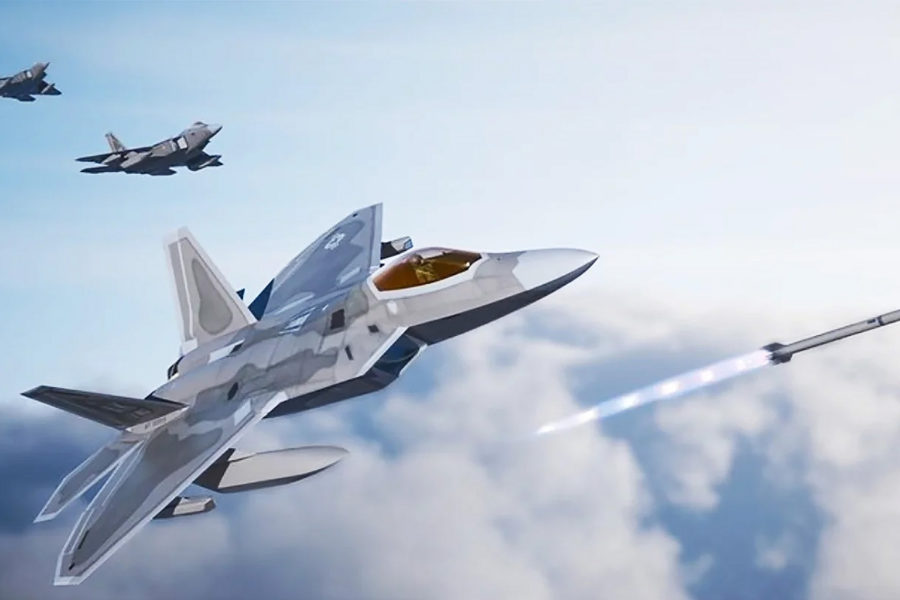The Air Force is successfully testing a number of classified sensor systems on the F-22 with technology that will be applicable to the Next-Generation Air Dominance system, officials said. The new technology could also extend the Raptor’s service life.
“The F-22 team is working really hard on executing a modernization roadmap to field advanced sensors, connectivity, weapons, and other capabilities,” Air Force fighters and advanced aircraft program executive officer Brig. Gen. Jason D. Voorheis told reporters last month at the Life Cycle Industry Days conference in Dayton, Ohio.
“The Raptor team recently conducted six flight test efforts to demo advanced sensors,” Voorheis said, and the service is planning a rapid prototyping effort to get them on the jet, he said.
“We’re executing that successfully, and that will lead to … a rapid fielding [Middle Tier of Acqusition program] in the near future,” Voorheis said.
Service officials have said that slender, chisel-like pods seen on a test F-22 last year are advanced infrared search-and-track (IRST) systems—which may include other sensors—that will expand the F-22’s ability to detect low-observable aircraft. The Air Force’s fiscal 2025 budget request for the F-22 describes ongoing test efforts with IRST. It’s part of an F-22 improvement campaign that calls for $7.8 billion in investments—$3.1 billion for research and development and $4.7 billion in procurement—before 2030.
Several years ago, Air Force leaders said the F-22 would likely retire around 2030. In recent months, however, officials have walked that back, and Voorheis said “from an F-22 sunsetting perspective, I don’t have a date for you.”
“What I can tell you is that we are hyper-focused on modernization to sustain that air superiority combat capability for a highly contested environment for as long as necessary,” he added.
That’s a notable shift from 2021, when then-Chief of Staff Gen. Charles Q. Brown Jr. revealed his “4+1” fighter plan that called for the F-22 to be supplanted by NGAD circa 2030, while retaining the F-35, F-15E and EX, and F-16. The “plus 1” was the A-10, but in March 2023, Brown said the A-10s were being divested faster than expected and will probably be all retired by 2030.
The F-22’s planned 2030 retirement raised eyebrows when Brown revealed the fighter plan, as the type is expected to have sufficient structural life to last into the 2040s. Service officials said at the time that the F-22’s 1980s-vintage stealth, though it has been updated, is being overtaken by new sensors in the hands of peer adversaries like China.
Voorheis offered one key to the F-22’s potentially extended longevity: a new government reference architecture compute environment, or “GRACE.” It is an open architecture software which will “enable non-traditional F-22 software” to be installed on the fighter, he said. It will permit “additional processing and pilot interfaces,” he added.
Voorheis is not the only official to suggest the F-22 could stick around longer than expected. In July, Gen. Kenneth Wilsbach, head of Air Combat Command, said he thinks the Air Force should not only retain the F-22, but keep the 32 older Block 20 Raptors the Air Force has twice asked Congress to retire.
The F-22 is “a fantastic aircraft,” Wilsbach said at the time. “We’re actually planning several upgrades to the jet as we speak,” and even those Block 20s that are not up to current standard are valuable for training.
“If we had to—in an emergency—use the Block 20s in a combat situation, they’re very capable,” he said.
Meanwhile, Air Force leaders have started to push back the timeline on the sixth-generation NGAD, long considered the F-22’s successor as the Air Force’s premier air superiority fighter. Wilsbach noted in July that until an NGAD contract is awarded, “there isn’t an F-22 replacement,” and just a few weeks later, Air Force Secretary Frank Kendall announced the service was “taking a pause” on NGAD.
The new technology modernizing the F-22 “supports all future programs,” Voorheis said, such as NGAD. “And we will leverage all of that technology as we go forward, on any platform.”
Collectively, the modernization effort “will ensure the F-22 remains the world’s [premiere] air superiority fighter, and retains that first-look, first-shot, first-kill advantage,” Voorheis said. The F-22 “is our bridge to NGAD,” and the technologies going into the Raptor will port to the NGAD “to ensure our ability to achieve air superiority in the future, highly-contested environment.”
